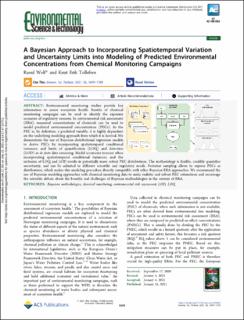| dc.contributor.author | Wolf, Raoul | |
| dc.contributor.author | Tollefsen, Knut-Erik | |
| dc.date.accessioned | 2021-07-16T09:12:21Z | |
| dc.date.available | 2021-07-16T09:12:21Z | |
| dc.date.created | 2021-02-04T08:29:11Z | |
| dc.date.issued | 2021 | |
| dc.identifier.citation | Environmental Science and Technology. 2021, 55 (3), 1699-1709. | en_US |
| dc.identifier.issn | 0013-936X | |
| dc.identifier.uri | https://hdl.handle.net/11250/2764627 | |
| dc.description.abstract | Environmental monitoring studies provide key information to assess ecosystem health. Results of chemical monitoring campaigns can be used to identify the exposure scenarios of regulatory concern. In environmental risk assessment (ERA), measured concentrations of chemicals can be used to model predicted environmental concentrations (PECs). As the PEC is, by definition, a predicted variable, it is highly dependent on the underlying modeling approach from which it is derived. We demonstrate the use of Bayesian distributional regression models to derive PECs by incorporating spatiotemporal conditional variances, and limits of quantification (LOQ) and detection (LOD) as de facto data censoring. Model accuracies increase when incorporating spatiotemporal conditional variances, and the inclusion of LOQ and LOD results in potentially more robust PEC distributions. The methodology is flexible, credibly quantifies uncertainty, and can be adjusted to different scientific and regulatory needs. Posterior sampling allows to express PECs as distributions, which makes this modeling procedure directly compatible with other Bayesian ERA approaches. We recommend the use of Bayesian modeling approaches with chemical monitoring data to make realistic and robust PEC estimations and encourage the scientific debate about the benefits and challenges of Bayesian methodologies in the context of ERA. | en_US |
| dc.language.iso | eng | en_US |
| dc.publisher | American Chemical Society | en_US |
| dc.rights | Navngivelse 4.0 Internasjonal | * |
| dc.rights.uri | http://creativecommons.org/licenses/by/4.0/deed.no | * |
| dc.title | A Bayesian Approach to Incorporating Spatiotemporal Variation and Uncertainty Limits into Modeling of Predicted Environmental Concentrations from Chemical Monitoring Campaigns | en_US |
| dc.type | Peer reviewed | en_US |
| dc.type | Journal article | en_US |
| dc.description.version | publishedVersion | en_US |
| dc.rights.holder | © 2021 The Authors. Published by American Chemical Society | en_US |
| dc.source.pagenumber | 1699-1709 | en_US |
| dc.source.volume | 55 | en_US |
| dc.source.journal | Environmental Science and Technology | en_US |
| dc.source.issue | 3 | en_US |
| dc.identifier.doi | 10.1021/acs.est.0c06268 | |
| dc.identifier.cristin | 1886551 | |
| dc.relation.project | Norges forskningsråd: 268294 | en_US |
| cristin.ispublished | true | |
| cristin.fulltext | original | |
| cristin.qualitycode | 2 | |

